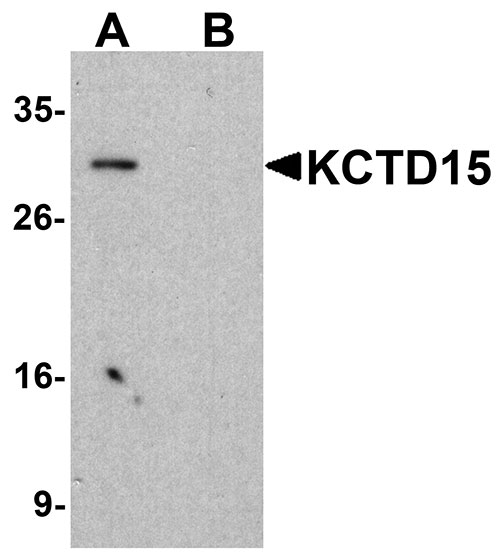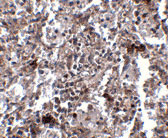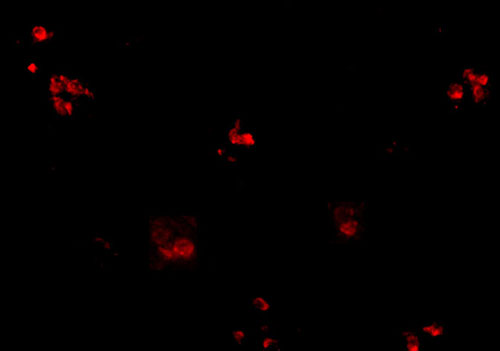KCTD15 Antibody
- 产品详情
- 实验流程
- 背景知识
Application
| WB, IF, E, IHC-P |
|---|---|
| Primary Accession | Q96SI1 |
| Other Accession | Q96SI1, 74732704 |
| Reactivity | Human, Mouse, Rat |
| Host | Rabbit |
| Clonality | Polyclonal |
| Isotype | IgG |
| Calculated MW | 31942 Da |
| Concentration (mg/ml) | 1 mg/mL |
| Conjugate | Unconjugated |
| Application Notes | KCTD15 antibody can be used for detection of KCTD15 by Western blot at 0.5 - 1 µg/mL. Antibody can also be used for immunohistochemistry starting at 2.5 µg/mL. For immunofluorescence start at 20 µg/mL. |
| Gene ID | 79047 |
|---|---|
| Other Names | BTB/POZ domain-containing protein KCTD15, Potassium channel tetramerization domain-containing protein 15, KCTD15 |
| Target/Specificity | KCTD15; |
| Reconstitution & Storage | KCTD15 antibody can be stored at 4℃ for three months and -20℃, stable for up to one year. As with all antibodies care should be taken to avoid repeated freeze thaw cycles. Antibodies should not be exposed to prolonged high temperatures. |
| Precautions | KCTD15 Antibody is for research use only and not for use in diagnostic or therapeutic procedures. |
| Name | KCTD15 |
|---|---|
| Function | During embryonic development, it is involved in neural crest formation (By similarity). Inhibits AP2 transcriptional activity by interaction with its activation domain (PubMed:23382213). |
| Cellular Location | Nucleus. |
For Research Use Only. Not For Use In Diagnostic Procedures.
Provided below are standard protocols that you may find useful for product applications.
BACKGROUND
KCTD15 Antibody: Childhood and adult obesity in the United States and to a lesser extent the rest of the world has increased dramatically over the past decade. Both environmental and genetic factors are involved in the onset and progression of weight gain. Recently, the potassium channel KCTD15 was identified as a genetic loci associated with higher than normal body mass index (BMI) in humans along with genes such as GNPDA2, MTCH2, FTO, and TMEM18. Further studies on single nucleotide polymorphisms (SNPs) in non-diabetic and diabetic patients showed that FTO was most strongly associated with obesity while MTCH2 and GNPDA2 were still significantly associated with higher than normal BMI levels. At least two isoforms of KCTD15 are known to exist.
REFERENCES
Hill JO. Genetic and environmental contributions to obesity. Am. J. Clin. Nutr.1998; 68:991-2.
Willer CJ, Speliotes EK, Loos RJ, et al. Six new loci associated with body mass index highlight a neuronal influence on body weight regulation. Nat. Genetics2009; 41:25-34.
Renstrom F, Payne F, Nordstrom A, et al. Replication and extension of genome-wide association study results for obesity in 4923 adults from northern Sweden. Human. Mol. Gen.2009; 18:1489-96.
终于等到您。ABCEPTA(百远生物)抗体产品。
点击下方“我要评价 ”按钮提交您的反馈信息,您的反馈和评价是我们最宝贵的财富之一,
我们将在1-3个工作日内处理您的反馈信息。
如有疑问,联系:0512-88856768 tech-china@abcepta.com.























 癌症的基本特征包括细胞增殖、血管生成、迁移、凋亡逃避机制和细胞永生等。找到癌症发生过程中这些通路的关键标记物和对应的抗体用于检测至关重要。
癌症的基本特征包括细胞增殖、血管生成、迁移、凋亡逃避机制和细胞永生等。找到癌症发生过程中这些通路的关键标记物和对应的抗体用于检测至关重要。 为您推荐一个泛素化位点预测神器——泛素化分析工具,可以为您的蛋白的泛素化位点作出预测和评分。
为您推荐一个泛素化位点预测神器——泛素化分析工具,可以为您的蛋白的泛素化位点作出预测和评分。 细胞自噬受体图形绘图工具为你的蛋白的细胞受体结合位点作出预测和评分,识别结合到自噬通路中的蛋白是非常重要的,便于让我们理解自噬在正常生理、病理过程中的作用,如发育、细胞分化、神经退化性疾病、压力条件下、感染和癌症。
细胞自噬受体图形绘图工具为你的蛋白的细胞受体结合位点作出预测和评分,识别结合到自噬通路中的蛋白是非常重要的,便于让我们理解自噬在正常生理、病理过程中的作用,如发育、细胞分化、神经退化性疾病、压力条件下、感染和癌症。








